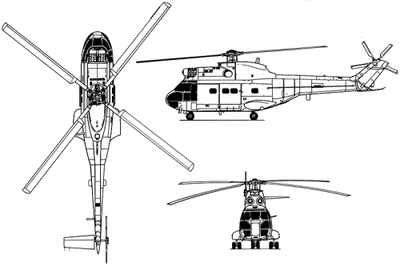Fri, Jan 24, 2014
Issued In Response To Offshore Oil Industry Super Puma Accidents
The U.K Air Accidents Investigation Branch is recommending that North Sea oil industry helicopter operators amend their safety briefings in light of an accident which resulted in multiple fatalities.

Special Bulletin S1/2014 was published on Thursday, January 23 concerning the accident to the AS332 L2 Super Puma helicopter, registration G-WNSB on Friday August 23. The accident occurred approximately 1.5 nm west of Sumburgh Airport, Shetland Islands.
This Special Bulletin is published to highlight a safety concern relating to pre-flight safety briefings, given to passengers, on the functionality of emergency equipment provided to them for UK North Sea offshore helicopter flights.
According to the bulletin, research has identified that in about 60% of all helicopter water impacts, the helicopter inverted or sank, immediately or after a short delay. A capsize often occurred before evacuation of the occupants could be completed. As a result, Emergency Breathing Systems (EBS) were developed to allow helicopter occupants to breathe underwater for a short period of time. The EBS can bridge the gap between the maximum breath-hold time of an occupant and the time required to complete an underwater escape, thereby increasing the chances of survival. EBS were introduced in UK North Sea offshore helicopter operations as a voluntary industry standard; at present there is no regulatory requirement for such equipment.
The pre-flight safety briefing material has been reviewed by the AAIB as part of its ongoing investigation. This has identified that the briefing material does not include fully representative information about the EBS. It does not highlight that the EBS provided may be a hybrid rebreather containing an air supply which is discharged automatically into the rebreather bag, or that the system can be used even if the wearer has not taken a breath before becoming submerged.

The AAIB has approached the main helicopter operators flying in support of the UK oil and gas industry, whose passengers are equipped with a hybrid EBS. Whilst operation of the hybrid EBS should be covered in initial and recurrent training, it is not explicitly described in the pre-flight safety briefing. The operators have undertaken to amend their pre-flight briefing material to include information that the hybrid system contains its own air supply which is discharged automatically, making the system usable even if the wearer has not taken a breath before becoming submerged.
More News
From 2014 (YouTube Version): One Of The Airshow World's Pre-Eminent Formation Teams Chats About The State Of The Industry At EAA AirVenture 2014, ANN News Editor Tom Patton gets th>[...]
Tactical Air Navigation (TACAN) An ultra-high frequency electronic rho-theta air navigation aid which provides suitably equipped aircraft a continuous indication of bearing and dis>[...]
Aero Linx: Doobert Hi, we're Chris & Rachael Roy, founders and owners of Doobert. Chris is a technology guy in his “day” job and used his experience to create Doobe>[...]
The Airplane Was Spinning In A Nose-Down Attitude Before It Impacted Terrain On June 20, 2025, at 0900 eastern daylight time, a Pitts Aerobatics S-2B, N79AV, was destroyed when it >[...]
Also: United Elite Sues, Newark ATC Transitions, Discovery Moves?, Textron @ KOSH The Commemorative Air Force Airbase Arizona is taking its “Flying Legends of Victory Tour&rd>[...]
 Classic Aero-TV: Up Close And Personal - The Aeroshell Aerobatic Team at Oshkosh
Classic Aero-TV: Up Close And Personal - The Aeroshell Aerobatic Team at Oshkosh ANN's Daily Aero-Term (07.13.25): Tactical Air Navigation (TACAN)
ANN's Daily Aero-Term (07.13.25): Tactical Air Navigation (TACAN) ANN's Daily Aero-Linx (07.13.25)
ANN's Daily Aero-Linx (07.13.25) NTSB Prelim: Pitts S2
NTSB Prelim: Pitts S2 Airborne 07.09.25: B-17 Sentimental Journey, Airport Scandal, NORAD Intercepts
Airborne 07.09.25: B-17 Sentimental Journey, Airport Scandal, NORAD Intercepts




